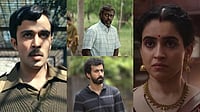Indian filmmaker Satyajit Ray donned several hats. Apart from being an astute filmmaker, he was also a screenwriter, author, lyricist, magazine editor, essayist, calligrapher, illustrator and music composer. Ray is considered as one of the greatest filmmakers whose works were ahead of time. He took the Indian cinema to the global arena. Ray, who is known as the Godfather of Indian cinema is celebrated for his thought-provoking works such as 'The Apu Trilogy' (1955–1959), 'The Music Room' (1958), 'Devi' (1960), 'Abhijan' (1962), 'The Big City' (1963), 'Charulata' (1964), 'Seemabaddha' (1971) and 'Ghare Baire' (1984) among others.
Today, on Satyajit Ray's birth anniversary, here's looking at some lesser known facts of the maverick auteur.
1. Worked as a visualiser in an advertising agency
Before trying his hands into direction, Satyajit Ray used to work as a junior visualiser for a British advertising agency. During his tenure at the agency, he delivered some of the best advertising campaigns.

2. Founded the first film club in Kolkata
In 1947, Ray founded the first film club in Kolkata. The first film to be screened in this club was ‘Battleship Potemkin’. He had a great passion for writing and wrote articles on cinema for newspapers and also wrote screenplays. His passion for writing led him to the world of filmmaking.
3. 'Bicycle Thieves’ was his inspiration behind filmmaking
During his London trip in 1950, Ray attended the screening of Vittorio De Sica’s ‘Bicycle Thieves’ which turned out to be the inspiration behind filmmaking. Vittorio inspired him to make the cult classic 'Pather Panchali' which was his dream project.
4. Ray made the first coloured Bengali film
‘Kanchenjunga’ (1962), which is considered as one of his best works, is the first coloured Bengali film. It is also regarded as the first Indian anthology film.

5. His documentary named ‘Sikkim’ was banned
One of his documentaries named ‘Sikkim’ (1971) was banned. Initially, it was commissioned by the Chogyal (king) of Sikkim. In 1975, when Sikkim came under India’s control, the documentary was banned by Indian Government. In 2010, the ban was lifted.
6. Recipient of 36 National Awards
The visionary filmmaker received 36 National Awards- 6 for Best Director. He won the prestigious award for his films such as ‘Chiriyakhana’ (1967), ‘Goopy Gyne Bagha Byne’ (1968), ‘Pratidwandi’ (1969), ‘Sonar Kella’ (1974), ‘Jana Aranya’ (1975) and ‘Agantuk’ (1991). Ray also bagged the National Award for Best Music Director twice – one for ‘Ashanti Sankt’ (1973) and another for ‘Hirak Rajar Deshe’ (1980).

7. Recipient of French Legion of Honour
He was also awarded with the Lgion d’honneur(Legion of Honour) in 1987 by the President of France for his extraordinary contributions in many fields.
8. Received Honourary Doctorate from Oxford University
Ray was awarded the honorary Doctorate by Oxford University. He became the second film personality to receive the honour after Charlie Chaplin.
9. First Indian to be conferred with the Oscar
A month before his death in 1992, Ray was honoured by the Academy at the 64th Oscar Awards for his lifetime achievement. He accepted his award from a hospital bed in Kolkata.

10. Honoured with the Bharat Ratna
Before his demise in 1992, the Government of India honoured the cinematic genius with the Bharat Ratna, the highest civilian award.

Born on May 2, 1921 in Kolkata, Satyajit Ray breathed his last on April 23, 1992, due to old age health issues.






















